![]()
![]()
![]()
![]()
![]()
![]()
![]()
![]()
![]()
![]()
![]()
![]()
![]()
![]()
![]()
![]()
![]()
![]()
![]()
![]()
![]()
![]()
![]()
![]()
![]()
![]()
![]()
![]()
![]()
Operating Accessories (Page 2 of 9)
In addition to adding visual interest and realism
to a train layout, Operating Accessories allow you operate it like
a real world-railroad rather than simply running trains around in
a circle. Gilbert made 62 distinct accessories as listed on
a little over seven pages of the TM Guide, not counting the
variations on some of the 62. Lionel made more under the
American Flyer name. Because there are so many, I have split
them up over four web pages:
Gilbert accessories #561
through #588 are on page
1
#591 through #752A are on this page
#755 through #762 are on page
3
#766 through 785 are on page
4
#787 through #23601 are on page
5
#23602 through #23786 are on page
6
#23787 through #23830 are on page
7
Lionel accessories #2300 through
#49807 are on page
7
#49808 through 49819 are on page
8
# 49820 and above are on page
9
Unless otherwise specified,
the pictures on this page are from the collection of The Upstairs
Train.

#591 Crossing Gate with 707 track
clip made in 1946 thru 1948.
It has a painted die-cast base.
A light underneath illuminates the lantern on the gate arm.
(Photo
courtesy of an anonymous donor.)
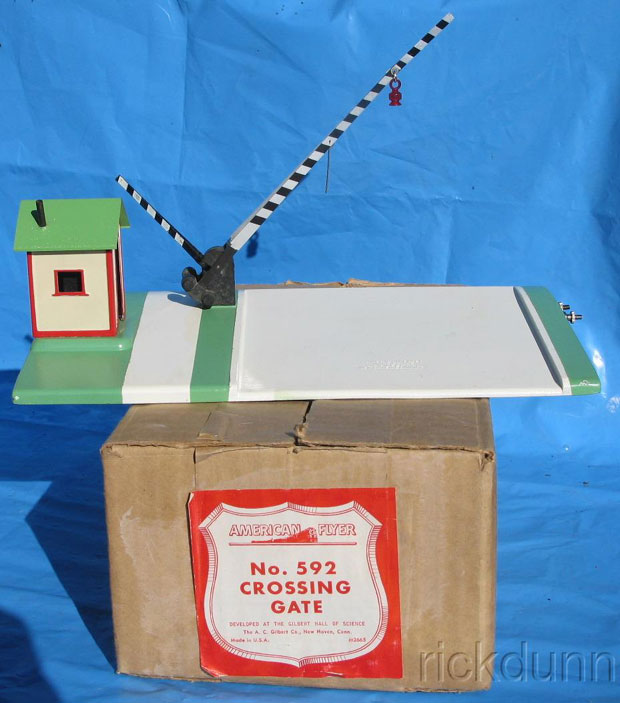
#592 Crossing Gate made in 1949 &
1950. It came with a with #697 track trip.
It has a
painted die-cast base. A light underneath illuminates the
lantern on the gate arm.
Notice the screw posts on the right
for connecting wires.
(Photo courtesy of Rick
Dunn.)
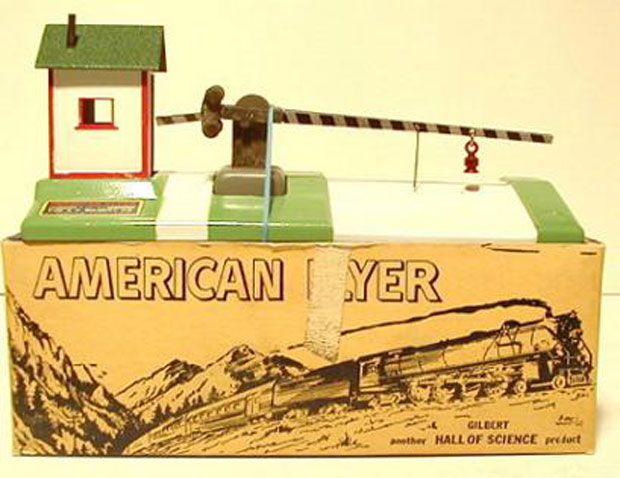
#592A Crossing Gate made in 1951 thru
1953 was similar but the roadway was narrower and cream
colored,
and the two wires were permanently connected. It
also came with a #697 track trip.
Some bases were diecast, some
Bakelite, and some Plaskon (pressed wood).
(Photo courtesy of
an anonymous donor.)
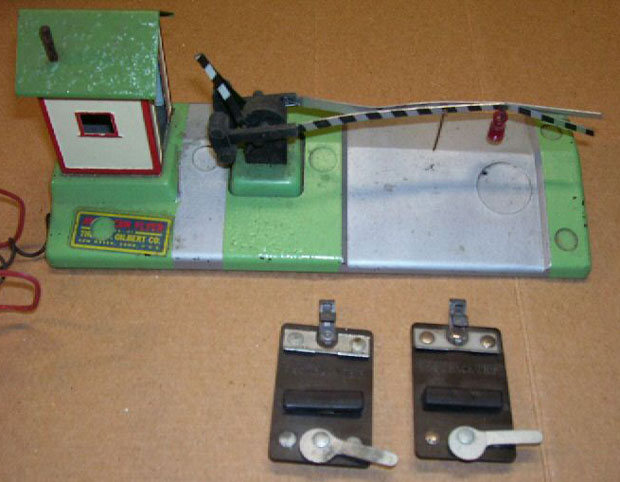
#592A Crossing Gate made in 1951 thru
1953 on a Plaskon base
with its distinctive silver painted
roadway and sidewalk.
(All three photos courtesy of Douglas
Weronick.)
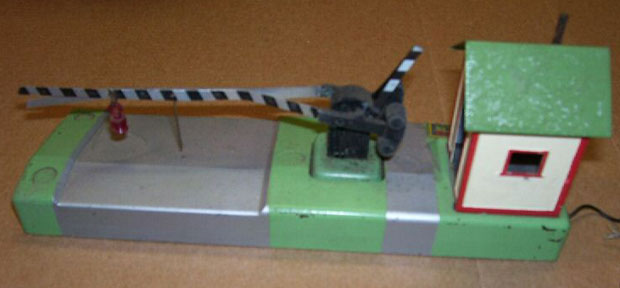
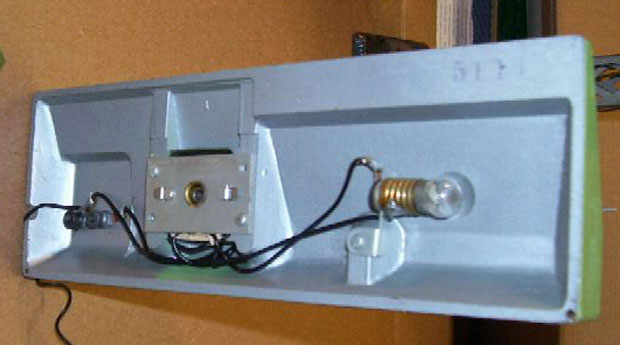
The underside is also quite distinctive.
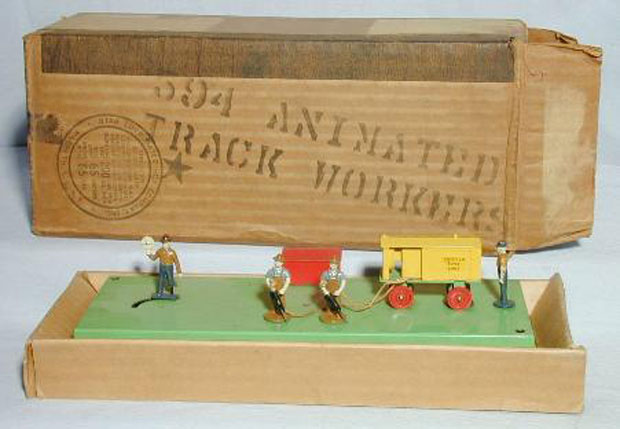
#594 Animated Track Gang made in
1941.
(Photo courtesy of an anonymous donor.)
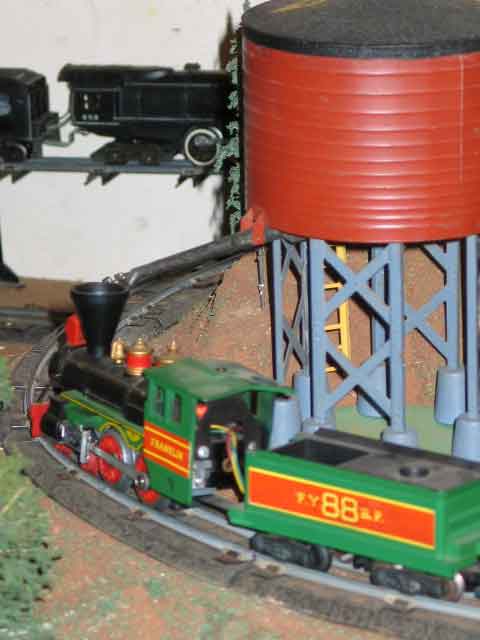
#596 Operating Water Tank.
There
were many variations: brown or burnt orange tank, gray or black
legs,
black or gray roof, made from 1946 thru 1956.
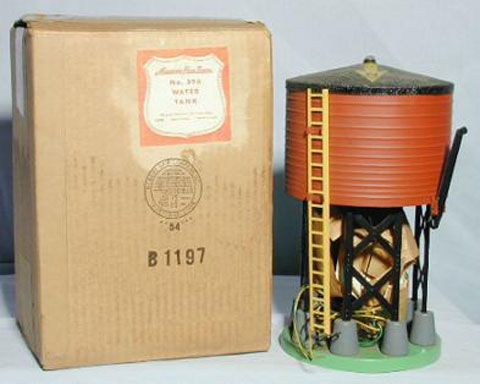
This one has black legs and roof and
no weight on the spout.
(Photo courtesy of an anonymous donor.)
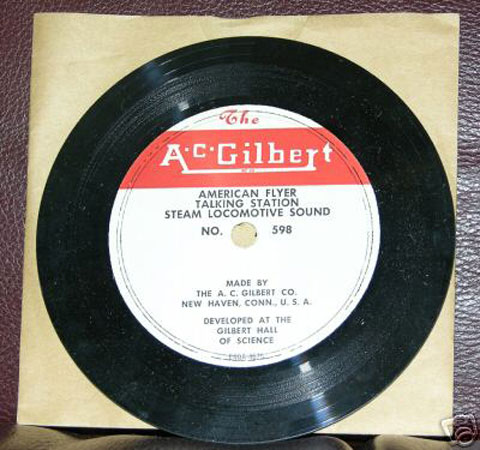
#598 Talking Station Record made in
1948 thru 1956.
One side of the record has steam engine sounds
and the other has diesel sounds.
There is a great deal of
variety in the labels on the records.
On some the colors are
the same on both sides, but on others they are not.
(Photos
courtesy of Richard
Purnell.)
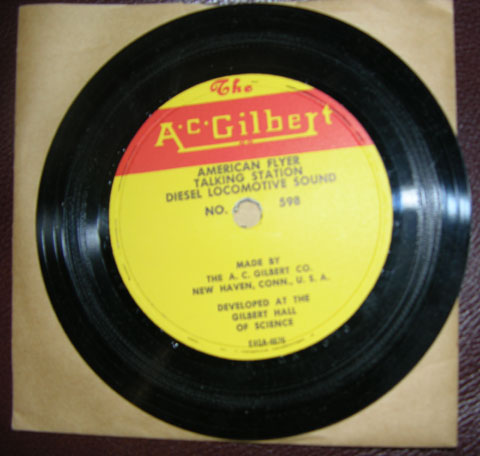
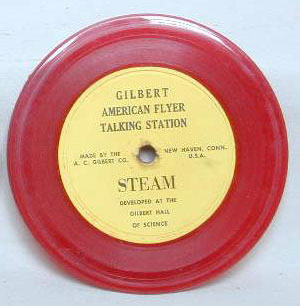
Some of the records weren't even
black!
Further, some bear the number 598 and some do not.
For
those that have no number, there is no way to tell whether it is a
598 or 23598;
the number appears only on the envelope it came
in.
(Photo courtesy of an anonymous donor.)
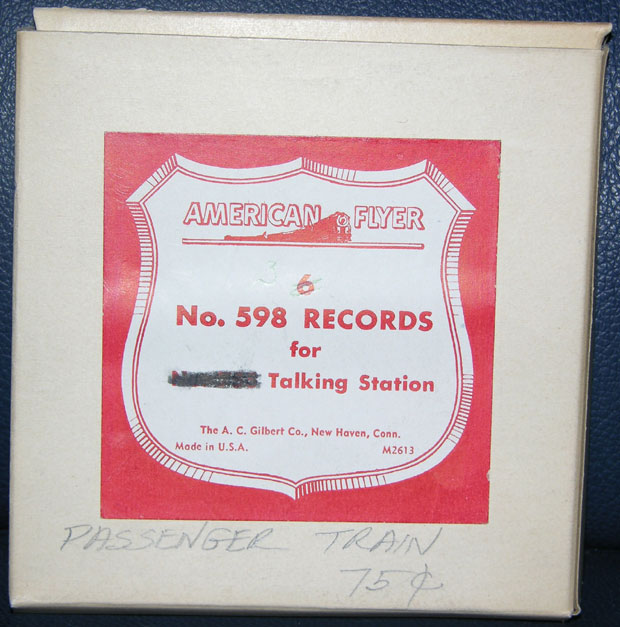
Recors were shipped to dealers in
6-pack boxes like this..
(Photo courtesy of Richard
Purnell.)
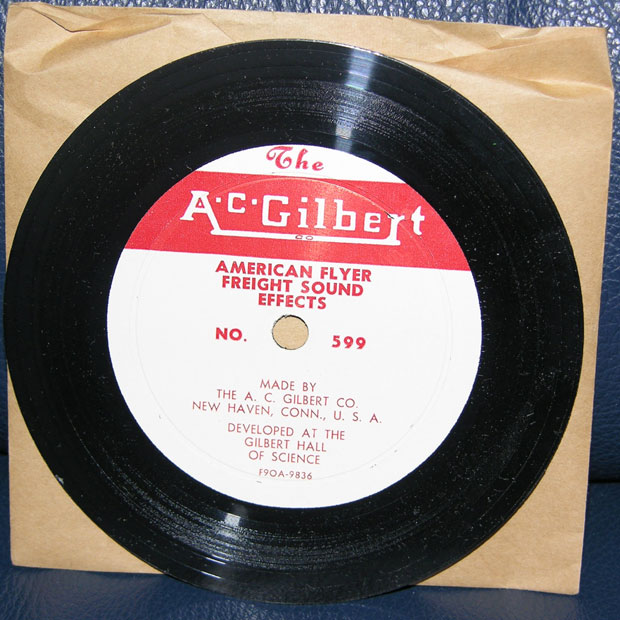
#599 Talking Station Record made in
1956. The labels on both sides are identical.
In addition
to the engine sounds contained on #598, the #599 record has
voices.
Greenberg says that on one side a dispatcher makes up a
freight train, and
on the second side the tower and conductor
discuss a hotbox problem.
(Photos courtesy of Richard
Purnell.)
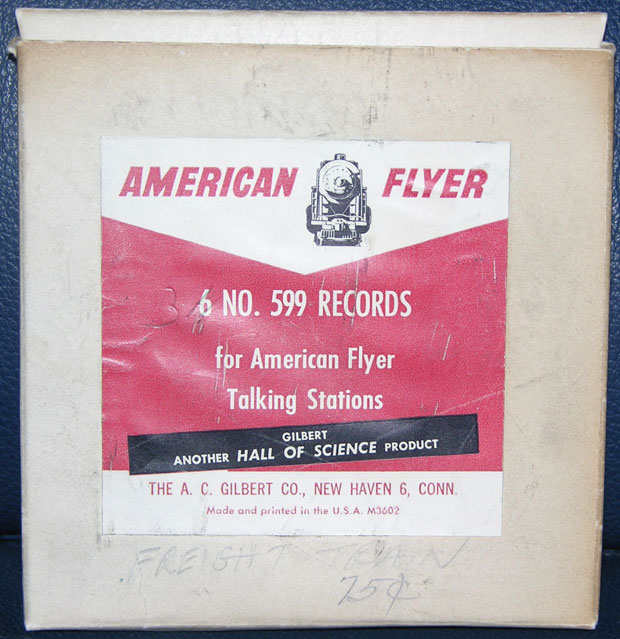
Records were shipped to dealers in
6-pack boxes like this..
(Photo courtesy of Richard
Purnell.)
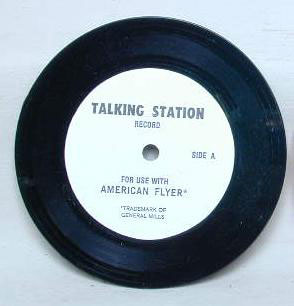
In 1969, General Mills acquired
Lionel and American Flyer.
This is one of their reissued #599
records.
(Photo courtesy of an anonymous donor.)
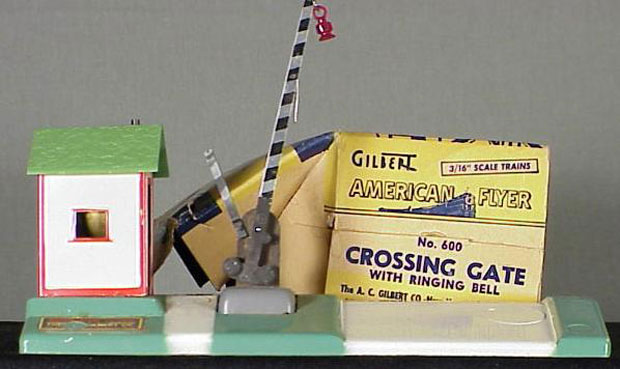
#600 Crossing Gate with 697 trip made
in 1954 thru 1956.
(Photo courtesy of an anonymous donor.)
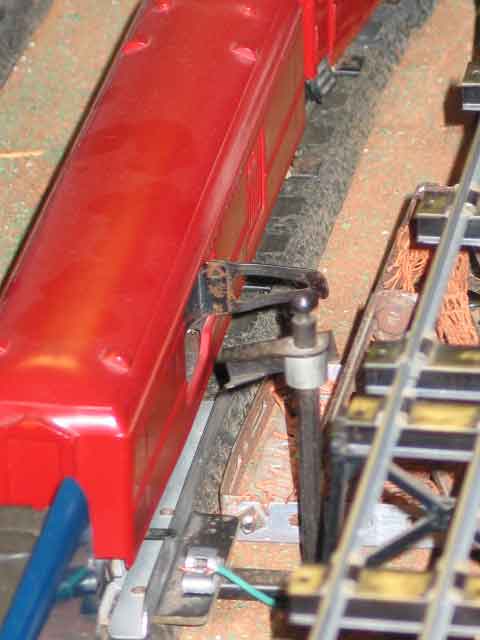
#718 Mail Car.
It tosses one mail bag out and
grabs another
off the #713 pickup arm as the mail car passes
by.
It's a wonderul thing to watch!
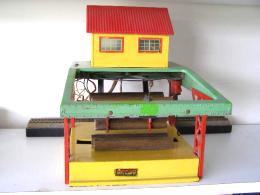
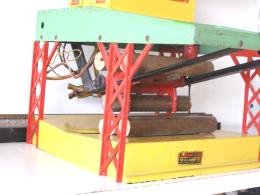
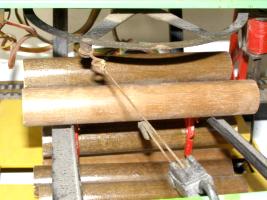
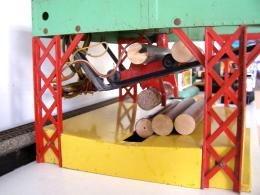
#751 Log Loader with yellow-painted
Bakelite base made in 1946 & 1947.
Notice the solenoid
wrapped in red electrical tape on the right, under the upper
deck.
It pulled the log cradle up to the cart on the
ramp.
(Photos courtesy of Kisers
Vintage Toys And Trains.)
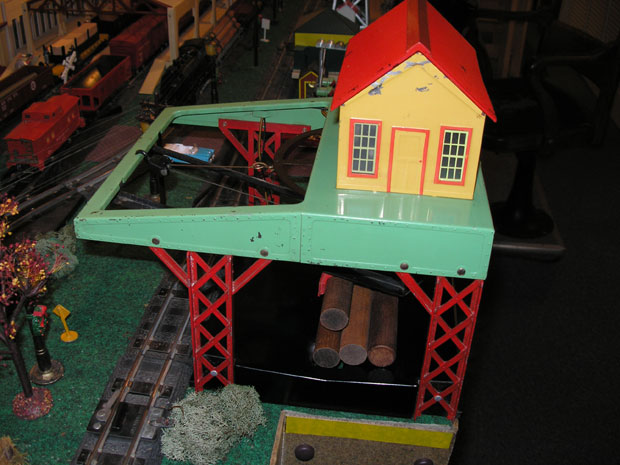
Both Greenberg and the TM Guide say
it was also made with a unpainted black Bakelite base in 1947 thru
1950,
but I have been told they were actually painted in 1947 thru
1949, and the switch wasn't made until 1950.
This one is from 1950
and it's unpainted.
One website visitor has one with an unpainted black base that is stamped
“June 1949.”
Does anyone have an unpainted black base from
1947 or 1948?
And does anyone have a painted black base? Can you positively identify the year?
(Photo courtesy of Mike Leahy.)
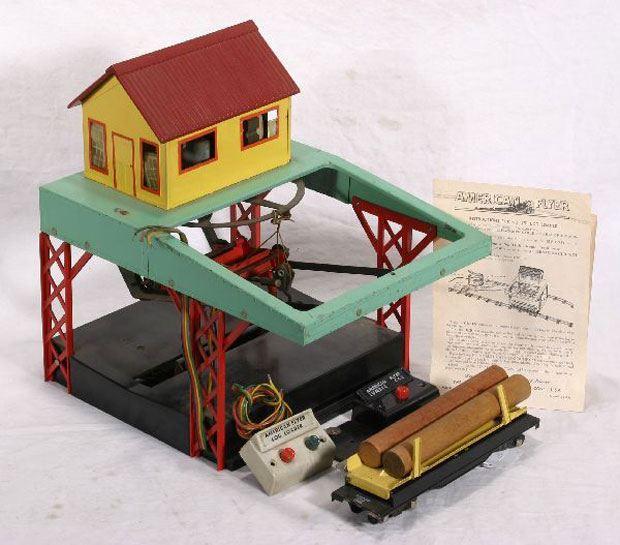
To improve its operation, Gilbert
made a mechanical design change in 1951.
The improved unit was
sold as #751A in 1951 thru 1953.
It's hard to tell the
difference unless you know exactly what to look for.
Instead of
pulling the cradle up, the #751A solenoid pushes
the cradle up.
It is mounted under the lower deck
by rivets, one of which is the little dimple you can see in the
picture;
the #751 deck surface above is clear (no
rivets).
Contrary to what Greenberg says, it had a black
Bakelite base as stated in the TM Guide.
Both books say it was
painted, but I have been told it was really unpainted.
Watch
this space while I confirm what's right.
The #717 log
unloading car was sold separately.
(Photo courtesy of New
England Toy & Train Exchange.)
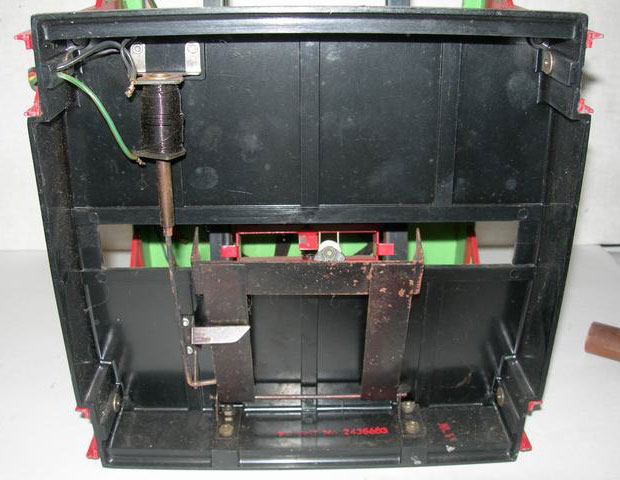
Here's a shot from below that shows
the solenoid and mechanical linkage.
No question about it: that
base is Bakelite, not metal.
(Photo courtesy of an anonymous
donor.)
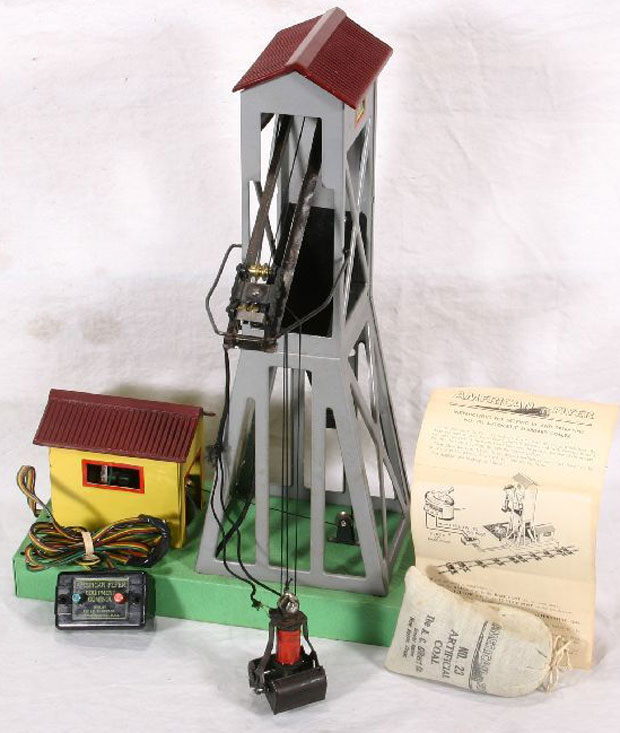
#752 Seaboard Coaler with two-button
control and a bag of coal; it was made in 1946 thru 1950.
(Photo
courtesy of New
England Toy & Train Exchange.)
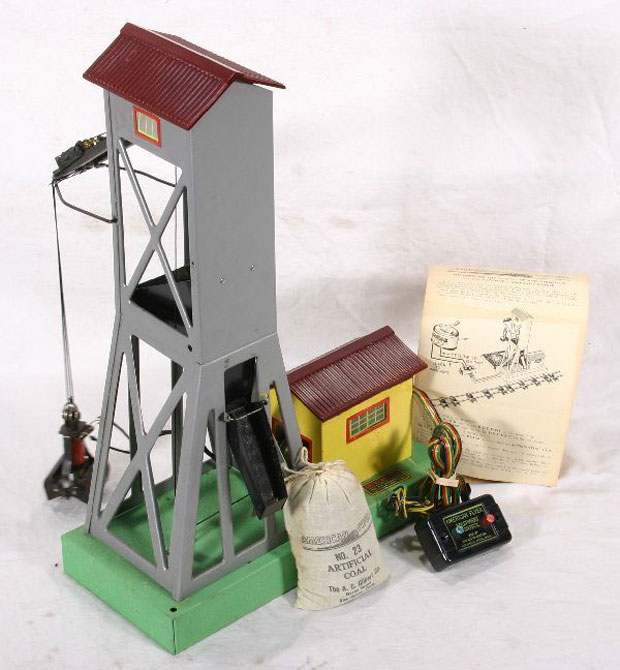
From the other side, you can see how
it operated. It was intended to be installed between two
tracks.
The scoop picks up coal from a car on one track, or
from the tray into which a dump car unloads.
The scoop then
lifts the coal up to the chute that delivers the coal into a car
waiting on the other track.
(Photo courtesy of New
England Toy & Train Exchange.)
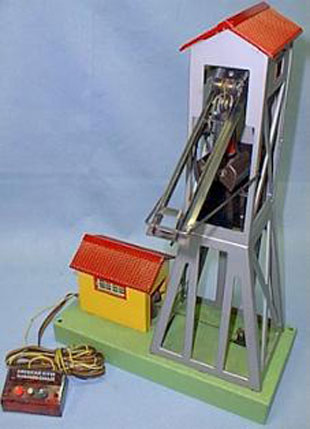
#752A Seaboard Coaler
with
three-button control
made in 1951 and 1952.
Because the
original #752 tended to
spray coal all over the place,
the
#752A had a bin at the top of the chute.
The third button
opened the trap door at the bottom of the bin. It helped,
but not much.
So Gilbert developed a wholly redesigned Coal
Loader, the #785, in 1955.
(Photo courtesy of an anonymous
donor.)
It takes time and money to maintain a website
like this. If this site is interesting and helpful to you,
please contribute financially to its ongoing success. You
may send
a contribution via PayPal using
theupstairstrain@yahoo.com as the payee. Both credit card and
direct transfers would be greatly appreciated. Thank you very
much.
If you or your friends have some American Flyer
trains and would like them to go to a nice home where they'll be
loved and cared for, this is the place! Email me:
theupstairstrain@yahoo.com. See my Wish
List for the items I need most.
Thank you very much.
On the other side of the coin, I post
pictures from time to time on my For
Sale page of surplus items I have for
sale.
This gallery will continue to grow and become more
comprehensive as I collect more equipment, and as visitors send me
pictures of the items I don't yet have. If you have a car,
engine, accessory, or set that you would like to share with the
world, email me a picture:
theupstairstrain@yahoo.com. Click
here for a list of the pictures I need
to complete the Gallery.
The books I am using for reference
are listed in the Bibliography
page. All the writing and all the pictures on
this website are, however, my own, except where cited. No
copyrighted materials have been included and all pictures provided
by others are used by permission.
Now show me:
The Gilbert Gallery Home Page
Engines
Passenger Cars
Freight Cars
Freight Sets
Work Cars
Accessories
Infrastructure
Operating Accessories
Buildings
Bridges
& Trestles Landscape
People
Pictures
Needed Useful
Links For
Sale Wish
List Bibliography
The
Upstairs Train